Masala Chai Taste
Your exploration of masala chai will uncover its rich heritage and the deep cultural roots that have wedged this beloved drink into the hearts of millions.
Historical Background
Masala chai, or spiced tea, originated in India thousands of years ago. According to historical records, it began as an ayurvedic herbal preparation. Only in the 1800s when the British established tea plantations in Assam did black tea leaves become a core ingredient, creating the masala chai you recognize today.
Cultural Significance
In India, masala chai is more than a drink; it's a symbol of hospitality and a staple in daily life. It's often enjoyed with breakfast or as an afternoon pick-me-up and shared with guests as a warm gesture of welcome. Each family has its own unique recipe, passing down a piece of heritage with every cup.
Bestsellers
Ingredients

When crafting masala chai, your selection of ingredients lays the foundation for its rich, complex flavor. Each ingredient contributes a distinct note. Below is a list of the key components:
Tea Base:
- Black tea: Typically, a strong variety like Assam is preferred for its robust flavor.
Spices (the "masala"):
- Cardamom: Green cardamom pods add a sweet, aromatic essence.
- Cinnamon: Sticks lend a warm, woody sweetness.
- Cloves: These bring a pungent, spicy quality.
- Ginger: Freshly grated ginger imparts a spicy kick.
- Black peppercorns: They offer an underlying heat.
Optional Additional Spices:
- Star anise: Delivers a licorice-like sweetness.
- Nutmeg: A pinch adds a nutty warmth.
- Fennel seeds: Contribute a subtle anise flavor.
Sweetener:
- Sugar or honey (to taste): Sweetness enhances the chai's myriad flavors.
Milk:
- The creaminess of milk balances the spice's intensity; choose from whole, skim, or a plant-based alternative.
Remember that the proportion of each ingredient should be adjusted to your taste preferences. The spices can be scaled up for a stronger masala punch or toned down for a subtler flavor profile.
Here is a simple tabular guide to the basic quantities for one cup of masala chai:
| Ingredient | Quantity |
|---|---|
| Black tea | 1 teaspoon |
| Cardamom pods | 2-3 |
| Cinnamon stick | 1 small piece |
| Cloves | 2-3 |
| Ginger | 1-inch piece |
| Black peppercorns | 2-3 |
| Sugar/honey | 1-2 teaspoons |
| Milk | 1/4 cup |
Adjust these amounts according to personal preference and taste. The joy of masala chai comes from fine-tuning the ingredients to create your perfect blend.
Preparation Techniques
To make a traditional cup of masala chai, begin by gathering your ingredients. You'll need black tea leaves, water, milk, sugar, and a blend of spices typically including cardamom, cinnamon, ginger, cloves, and black pepper.
Step 1: Spice Blend
Lao Ban Zhang
- Crush the spices coarsely using a mortar and pestle or a grinder. Your blend can be tailored to your liking, allowing more cardamom for a sweeter scent or extra ginger for a spicier kick.
Step 2: Boiling Water and Spices
- Heat water in a saucepan. Once simmering, add your spice mix to it, and allow the spices to infuse the water for a rich flavor.
| Quantity | Ingredient |
|---|---|
| 1 cup | Water |
| 1 tsp | Masala mix |
Step 3: Adding Tea Leaves and Simmer
- Add the black tea leaves to the spiced water. Let it simmer for a few minutes to extract the flavors from the tea.
| Quantity | Ingredient |
|---|---|
| 1 tsp | Black tea |
Step 4: Milk and Sugar
- Pour in the milk and add sugar to taste. For a creamier texture, full-fat milk is recommended, though any variety works.
| Quantity | Ingredient |
|---|---|
| 1 cup | Milk |
| To taste | Sugar |
Step 5: Final Simmer and Strain
- Allow the chai to come to a gentle boil, then reduce the heat and let it simmer. Keep an eye on the pot as milk can quickly boil over. After a few minutes, turn off the heat, and strain the masala chai into cups.
By following these steps, you will achieve an aromatic and warming cup of masala chai that's steeped in the flavors of India.
Flavor Profile
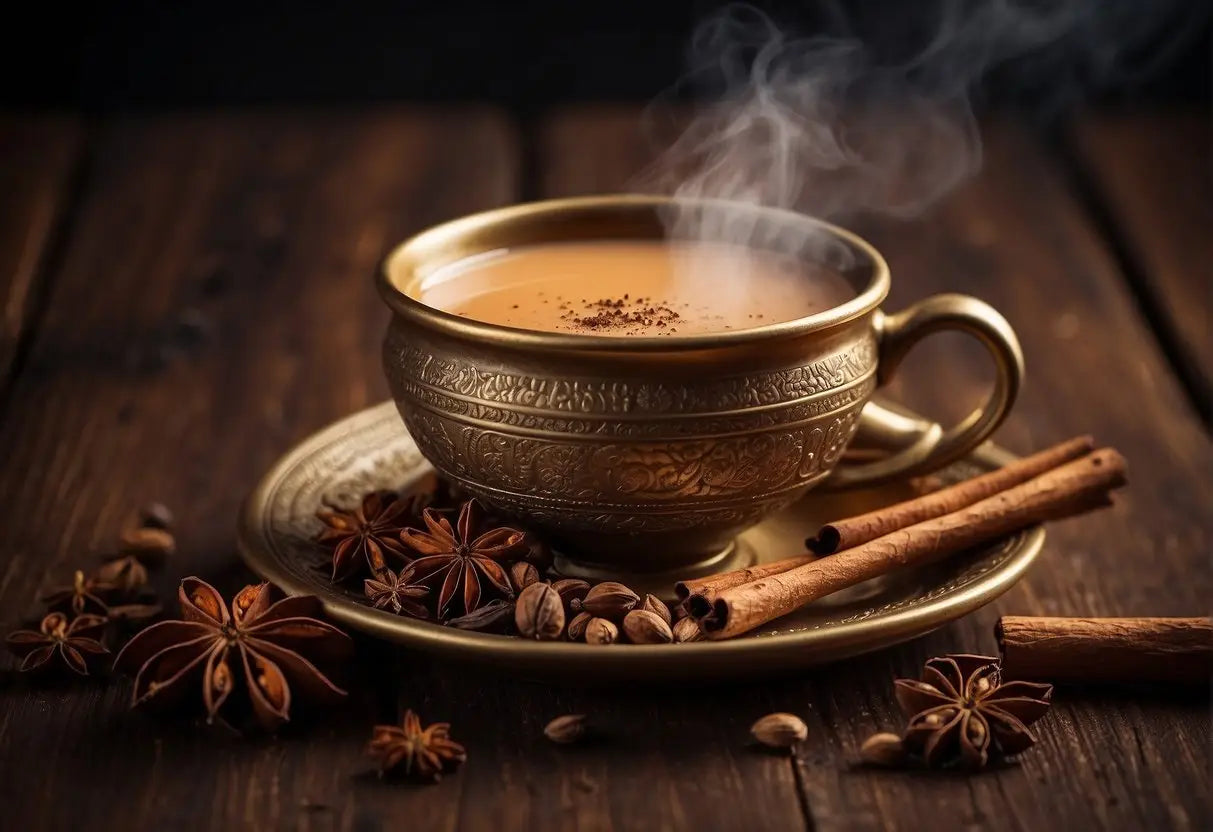
The flavor of masala chai is a rich tapestry, woven from its varied spice blends, diverse tea bases, levels of sweetness, and the type of dairy used.
Spice Blend Nuances
Black peppercorns: A warm, piquant flavor that adds depth.
Cinnamon: Provides a sweet, woody taste, often at the forefront.
Cardamom: Delivers a citrusy and piney nuance that is unmistakably aromatic.
Ginger: Offers a spicy, fresh zing, commonly noted for its kick.
Cloves: Contribute a pronounced, slightly bitter warmth.
Nutmeg: Rounds out the flavor with a nutty, slightly sweet note.
Tea Base Varieties
- Assam: A robust, malty flavor that anchors the spice mix firmly.
- Darjeeling: A lighter, floral note that elevates the subtleties of the spices.
- Ceylon: Offers a balance of strength and citrus that merges well with the spices.
Sweetness Levels
Sugar or honey can be added to enhance the spices and combat their heat, creating a balanced sweet profile. The ideal level of sweetness is personal, ranging from none to very sweet.
Dairy Influence
- Whole milk: Creates a creamy, full-bodied texture and taste.
- Skim milk: Offers a lighter feel with a muted creaminess.
- Plant-based milk: Almond, coconut, or soy can provide subtle complementary flavors.
By understanding these components, you can better appreciate the complex taste of masala chai.
Sensory Experience
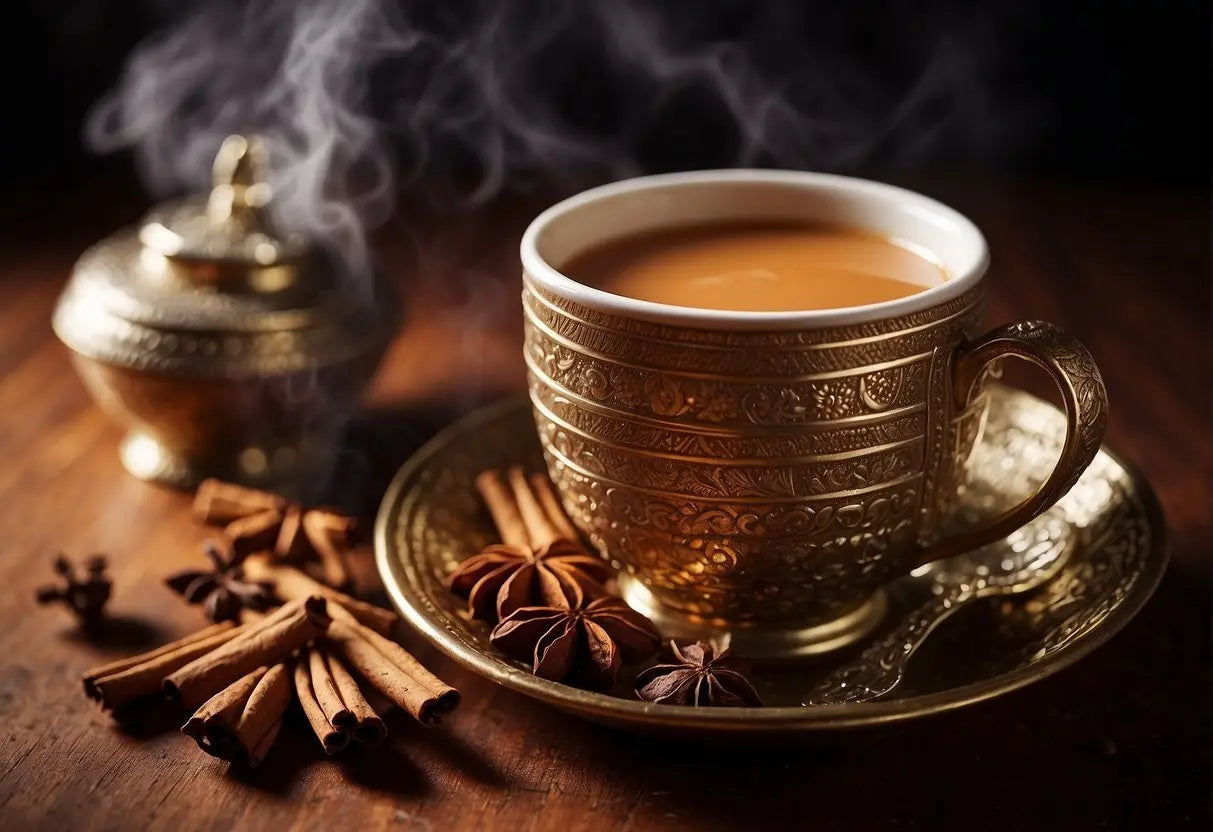
In experiencing masala chai, your senses are engaged through the distinct aroma, visual appeal, and unique texture of this spiced tea.
Aroma Characteristics
The aroma of masala chai is immediately noticeable. The spices, each with their own fragrant properties, release a warm and inviting scent. You'll detect:
- Cardamom: Sweet and spicy with a slight hint of pine
- Cinnamon: Woody and earthy with a comforting sweetness
- Ginger: Sharp and peppery with a fresh, pungent smell
- Cloves: Intense and slightly sweet
- Black Pepper: Piquant with a warm, woody fragrance
Visual Aspects
The visual appeal of masala chai contributes to its overall sensory experience. Expect to see:
- A rich, amber-brown hue
- A slight translucency, depending on milk content
- Occasionally, spice remnants floating or settled at the bottom
Texture and Mouthfeel
The texture of masala chai is as important as its taste. Consider these factors:
- Creaminess: Often from milk, providing a velvety smoothness
- Bodiness: Assessed by the weight on your palate, typically full-bodied due to the robust tea and spices
- Astringency: Slight dryness from the tannins in the black tea leaves
Regional Variations
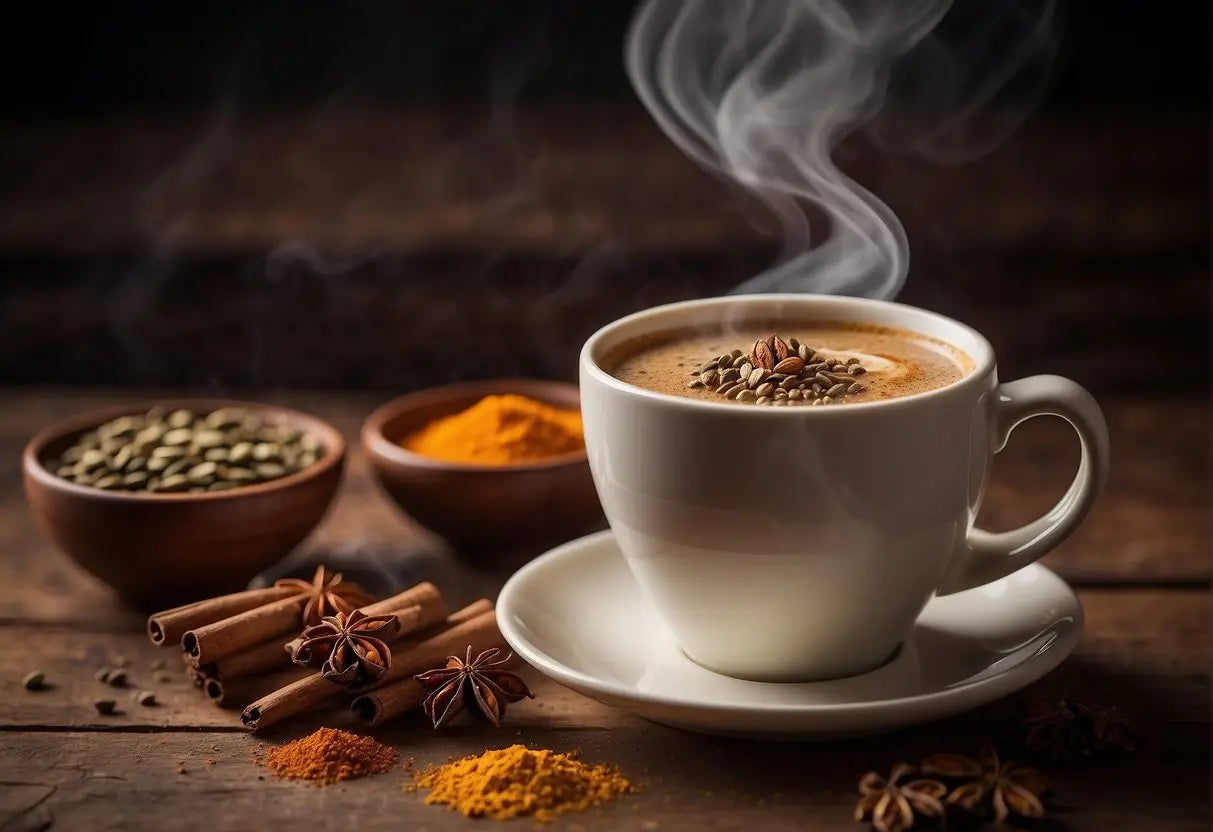
When you explore the regional variations of masala chai, you'll find that each area adds its own touch to this iconic beverage. In Kolkata, Bengali Masala Chai typically features a mixture of spices, including cardamom, cloves, and cinnamon, giving it a warm and soothing flavor profile.
Heading south to Mumbai, you'll encounter a version that often includes more peppery notes, with ginger being a prominent ingredient. This results in a zestier taste compared to the Kolkata interpretation.
Moving towards Kashmir, Kahwa is a unique take on chai. It's a green tea-based drink mixed with saffron, cinnamon, and cardamom, often garnished with almonds and walnuts. It's less milky but rich in flavors.
In Gujarat, the chai is sweeter and known as batrisu. It incorporates a 32-spice blend that creates a complex and aromatic experience.
Below is a simplified breakdown:
| Region | Distinctive Spice/Ingredient | Overview |
|---|---|---|
| Kolkata | Cardamom, cloves, cinnamon | Warm and soothing |
| Mumbai | Ginger, pepper | Zesty and robust |
| Kashmir | Saffron, almonds, walnuts | Rich, less milky, spice-forward |
| Gujarat | 32-spice blend | Sweet and aromatic |
Your experience of masala chai will vary greatly depending on where you're enjoying your cup. Each region brings something special to the table, making masala chai not just a drink, but an exploration of culture and taste.
Health Benefits and Considerations
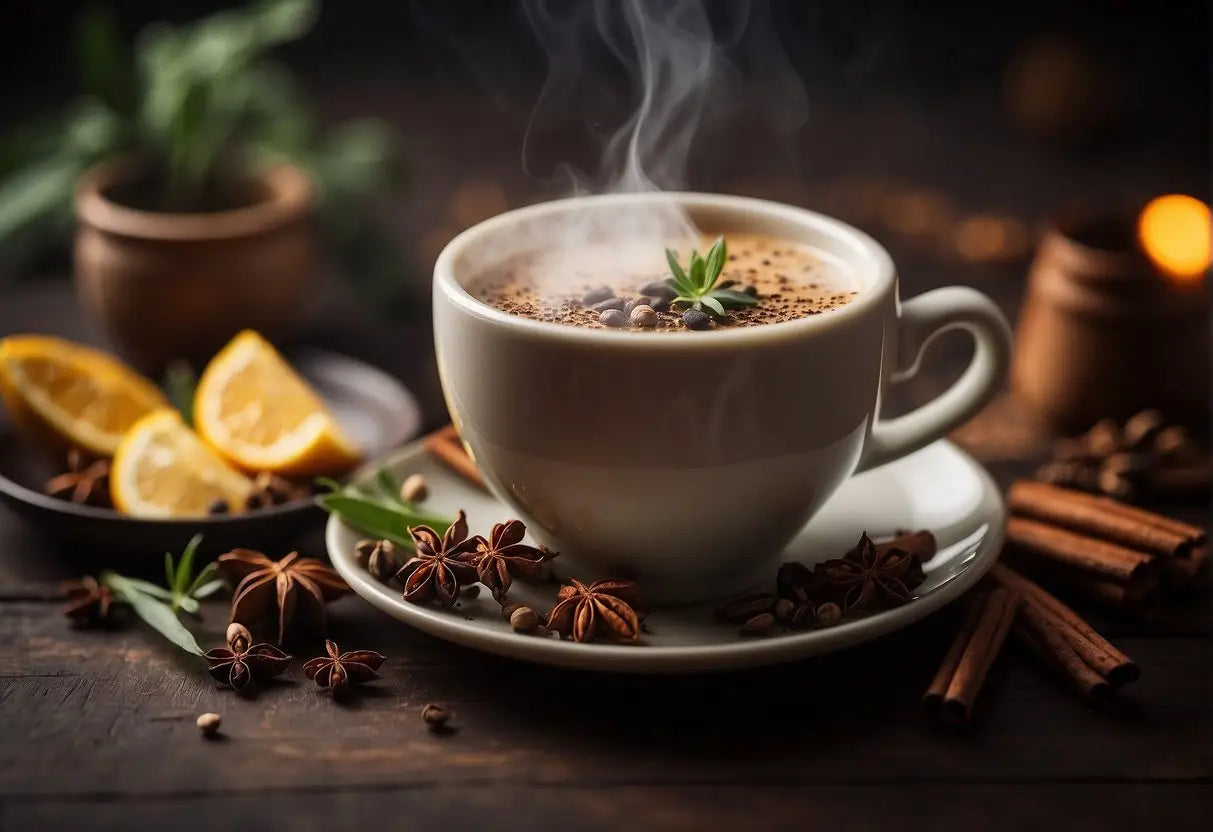
When enjoying masala chai, you encounter a wealth of ingredients that do more than just tantalize your taste buds. Each spice in masala chai offers its own health benefits.
- Ginger: Often used for its anti-inflammatory properties and to aid digestion.
- Cardamom: Believed to help in detoxification and to possess anti-inflammatory effects.
- Cinnamon: Contains antioxidants and may help regulate blood sugar levels.
- Cloves: Known for their antimicrobial properties and can aid in pain relief.
- Black Pepper: May improve digestion and has potential antioxidant effects.
While the spices in masala chai can offer health benefits, it's important to consume it in moderation due to other ingredients like sugar and caffeine, which can have the opposite effect if you intake too much. Remember the following:
- Caffeine content varies, depending on the type of tea used as the base, potentially affecting sleep if consumed close to bedtime.
- Adding excessive sugar can negate the drink's health benefits and contribute to increased caloric intake.
To get the most out of masala chai, consider using a natural sweetener like honey if sweetness is desired, and keep an eye on the amount of chai you consume daily. It's best to inform yourself of how each spice affects you personally, as some individuals may experience allergic reactions or adverse effects due to medical conditions or medication interactions. Always consult with a healthcare professional if you have any concerns about including masala chai in your diet.
Pairings and Serving Suggestions
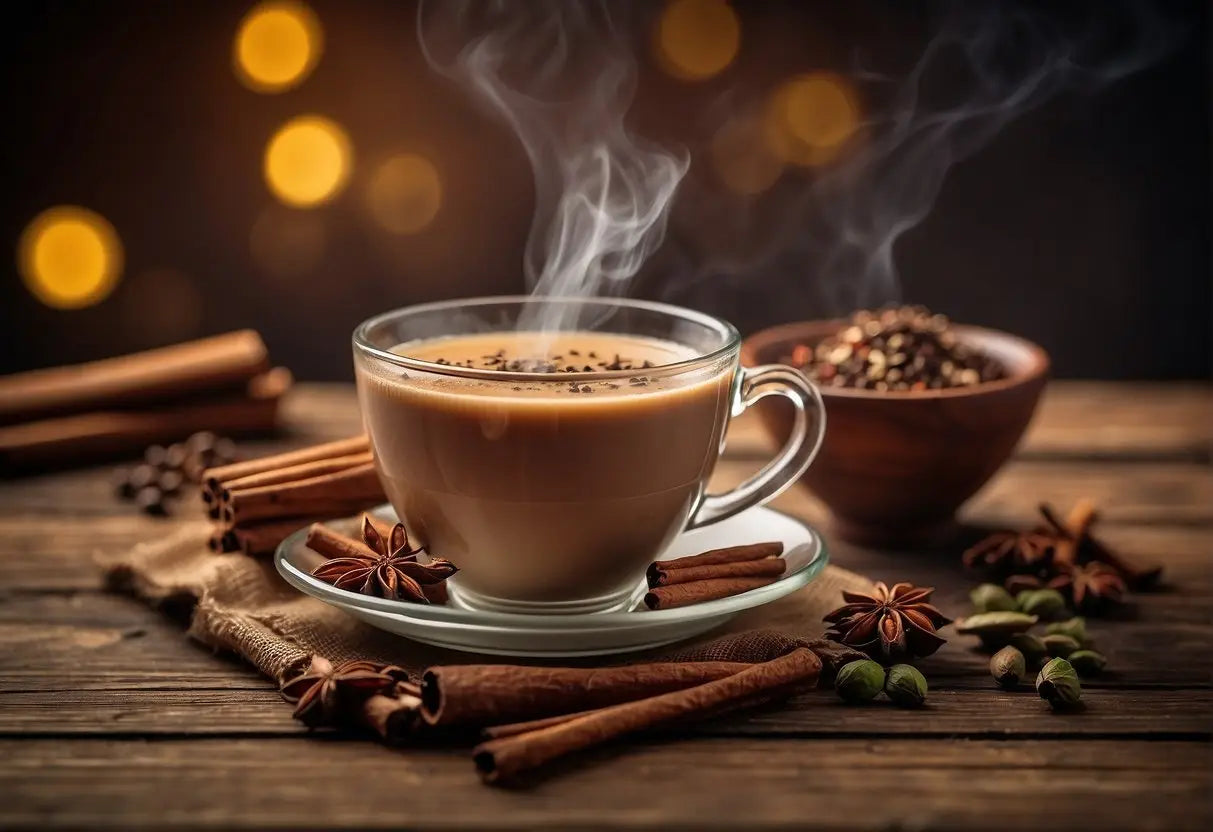
When enjoying Masala Chai, certain foods pair exquisitely with its complex flavors:
Sweet Delights:
- Biscotti: A crunchy biscotti complements the warmth of the tea.
- Gulab Jamun: These sweet, syrupy balls are a decadent match.
- Chocolate Cake: The intensity of chocolate balances chai's spice.
Savory Snacks:
- Samosas: The spiciness of chai cuts through the rich pastry.
- Cheese Straws: A cheesy, flaky texture pairs well with masala chai's boldness.
- Nuts & Seeds: Almonds or pumpkin seeds provide a crunchy contrast.
Serving Suggestions:
- Glass vs. Cup: Serve in a clear glass to appreciate the color, or a clay cup to retain the warmth.
- Temperature: Best served hot, but can be enjoyed as an iced alternative.
- Milk: To enhance creaminess, add milk or a milk substitute.
- Sweetness: Sweeten with sugar, honey, or jaggery to taste, balancing the spices.
Remember, the key is to enjoy the interplay of flavors that masala chai and these foods bring to your palate.
← Older post Newer post →











